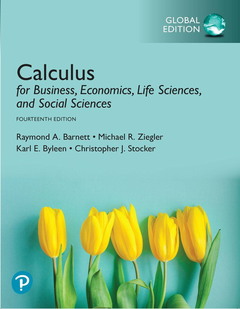Description
Calculus for Business, Economics, Life Sciences, and Social Sciences, Global Edition (14th Ed.)
Authors: Barnett Raymond, Ziegler Michael, Byleen Karl, Stocker Christopher
Language: English
Subject for Calculus for Business, Economics, Life Sciences, and...:
92.37 €
In Print (Delivery period: 14 days).
Add to cart824 p. · 22x27.5 cm · Paperback
Description
/li>Contents
/li>Comment
/li>
For two-semester courses in Calculus.
Calculus for Business, Economics, Life Sciences, and Social Sciences, 14th Edition offers more built-in guidance than any other text in its field ? with special emphasis on applications and prerequisite skills ? and a host of student-friendly features to help students catch up or learn on their own. The text?s emphasis on helping students ?get the idea? is enhanced in the new edition by a design refresh and updated data and applications.
- 1. Functions and Graphs
- 2. Limits and the Derivative
- 3. Additional Derivative Topics
- 4. Graphing and Optimization
- 5. Integration
- 6. Additional Integration Topics
- 7. Multivariable Calculus
- 8. Differential Equations
- 9. Taylor Polynomials and Infinite Series
- 10. Probability and Calculus
- Appendix A: Basic Algebra Review
- Appendix B: Special Topics
- Appendix C: Integration Using Tables
- Answers
- Index of Applications
- More than 300 completely worked examples introduce concepts and demonstrate problem-solving techniques.
- Matched Problems accompany each of the worked examples to help students gain solid knowledge of the basic topics and assess their own level of understanding before moving on.
- In order to emphasise problem solving, concepts, and computational skills, most derivations and proofs are omitted, except where their inclusion adds significant insight into a particular concept.
- Full-colour design and modern look helps students navigate the text and enhances its pedagogical features. The revised design is free of potentially distracting elements. The figures in the text have been re-rendered using the latest software and re-conceived to take advantage of a full colour palette in order to maximise their instructional potential.
- The variety of exercise types and difficulty levels enable instructors to easily craft homework assignments tailored to their students’ needs:
- Exercise sets at the end of each section consist of Skills Warm-up problems that review prerequisite knowledge specific to that section, followed by problems that are categorised according to level of difficulty (A, B, and C), followed by Applications.
- Applications give students substantial experience in modelling and solving real-world problems. Almost every exercise set contains application problems that were derived from real-world situations.
- Chapter Reviews include a comprehensive summary of important terms, symbols, and concepts, keyed to completely worked examples, and are followed by a set of Review Exercises.
- A Diagnostic Prerequisite Test assesses students’ prerequisite skills prior to taking the course and provides a Basic Algebra Review to help them remediate in specific areas of need.




